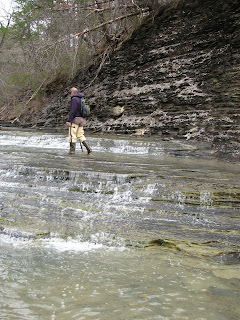For More Jewelry Tips, Information and
Projects,Visit Us Online
Not too long ago I had the occasion to go on a hunt for Kentucky Agate with my family. My son, Robert and I, wrote this wonderful article that was printed in my now out of print magazine "Wire Art". I loved the trip so much that I wanted to share our adventure with all of you again. Are you ready? Here we go.
The blue sky blanketed over the green hillsides as the clear
rocky creek cut it in two. The still quiet air filled our lungs as we head out
on our adventurous hunt for the ever beautiful, ever elusive Kentucky Agate.
The adventure begins as I first meet up with my guide and master
agate hunter Roland McIntosh at his workshop that lies at the foot of his hillside
home. Roland is by far one of the nicest people you’ll ever meet. His ‘down
home’ country demeanor makes you feel welcomed. From the beginning it felt like
we were long lost friends reuniting after years apart. His humble manner and
easygoing attitude immediately set me at ease.
Our Guide, Roland McIntosh
After pleasantries and introductions he gave me the grand
tour of his workshop. Looking around the
outside of his shop I witnessed the largest collection of Kentucky agate that I’ve
ever seen. There were piles upon piles of geodes all around his building. The
stockpile of agate was almost unimaginable. At the time I didn't realize it, but this was
very beneficial to see, for now I have a slight clue as to what we were
searching for.

Roland, whose knowledge about this beautiful stone is
seemingly unmatched, has been hunting this rare stone for over 27 years. In
that time, he’s had to self-educate himself about Kentucky agates, gleaning as
much information as he could from fellow hunters. Kentucky Agate is only found
in a small region of Eastern Kentucky. It ranges in color from brilliant red,
orange, yellow, and burgundy to subtle pastels of lavender, pink, and green.
Roland pointed out that out of all of the color combinations that the stone is
found in, the rarest is red and black. This, however, was the inside of the
specimen. What makes finding Kentucky Agate so difficult is differentiating it
from other stone. In many cases it looks like everything else in the creek bed.
Roland turned a specimen over and pointed out how to identify the treasure we
were looking for. I needed to keep my eye out for a large, egg-shaped stone
with a tan to brown exterior. I spent a few minutes studying the target that he
and I would be searching for. The education that I received from this mineral
hunting sage was priceless. The more he spoke, the more excited I got.

Once the lesson concluded, we started our trek through the
hills of Kentucky. Gorgeous hills and valleys fill our eyes and the blue sky
covers our heads as we walked over to the hunting grounds armed with our wits,
sharp eyesight, and a bag to hold our catch. We headed up a creek that Roland has
hunted from previously and knew well. Even though he's been there before, the
rains and other storms that hit a few days before kicked up new stones for us
to find and explore.

As we walked upstream, thoughts of the treasures that we'd
find filled my head. Shortly after the hunt began we encountered our first
signs of wild life. The creek we were exploring ran through a pasture where a
quiet herd of cows were hungrily feeding on fresh grass. Roland seemed
unaffected by their presence as he climbed the pasture gate. “I’m not worried
about the cows”, he said with a grin, “I’m looking for the bull”. This statement heightened my concern about
what we would encounter the deeper into the creek we explored. I took a deep
breath, said a quick prayer, and made my way over the gate. Thankfully, no bull
was present.
The "Dangerous" Wildlife
Without a doubt the one thing that helped me on the journey
was Roland. His accurate and vast knowledge of the area and different stones
proved to be quite an asset. His easy going nature came in handy as well.
Throughout the entire trek I kept picking up stone after stone, rock after
rock, bringing it to my hunting guide for approval, not one of them being the
correct stone. I must have picked up the entire creek bed and brought it to him
for inspection. With each specimen that I presented to him he would
nonchalantly say, “That’s junk”. His disapproval at first was hard to take, but
after the first fifty rejections it almost became a joke. It was a good thing Roland
doesn't frustrate easily. If not for him I think I would have left the creek
with five tons of flint and iron ore. It seemed as if the creek was dominated by
these imposters, making it difficult and tiresome to find our treasure. But
like any good treasure hunt - the harder the work the better the pay off. This hunt would have been much easier if we
had a pirates treasure map with a huge “X” marking the spot. But all we had is
a very very long hike and a lot of time. Hiking through the creek, you felt as
if you would never find your treasure. Stone after stone, bend after bend, and
no sign of the agate.

"That's Junk"
Will we ever find our treasure? Tune in next week for the exciting conclusion of "The Great Kentucky Agate Hunt!"
For More Jewelry Tips, Information and
Projects,Visit Us Online
























